If you buy through our links, we may earn an affiliate commission. This supports our mission to get more people active and outside.Learn about Outside Online's affiliate link policy
The 8 Best All-Mountain Skis of 2026, Tested by Experts
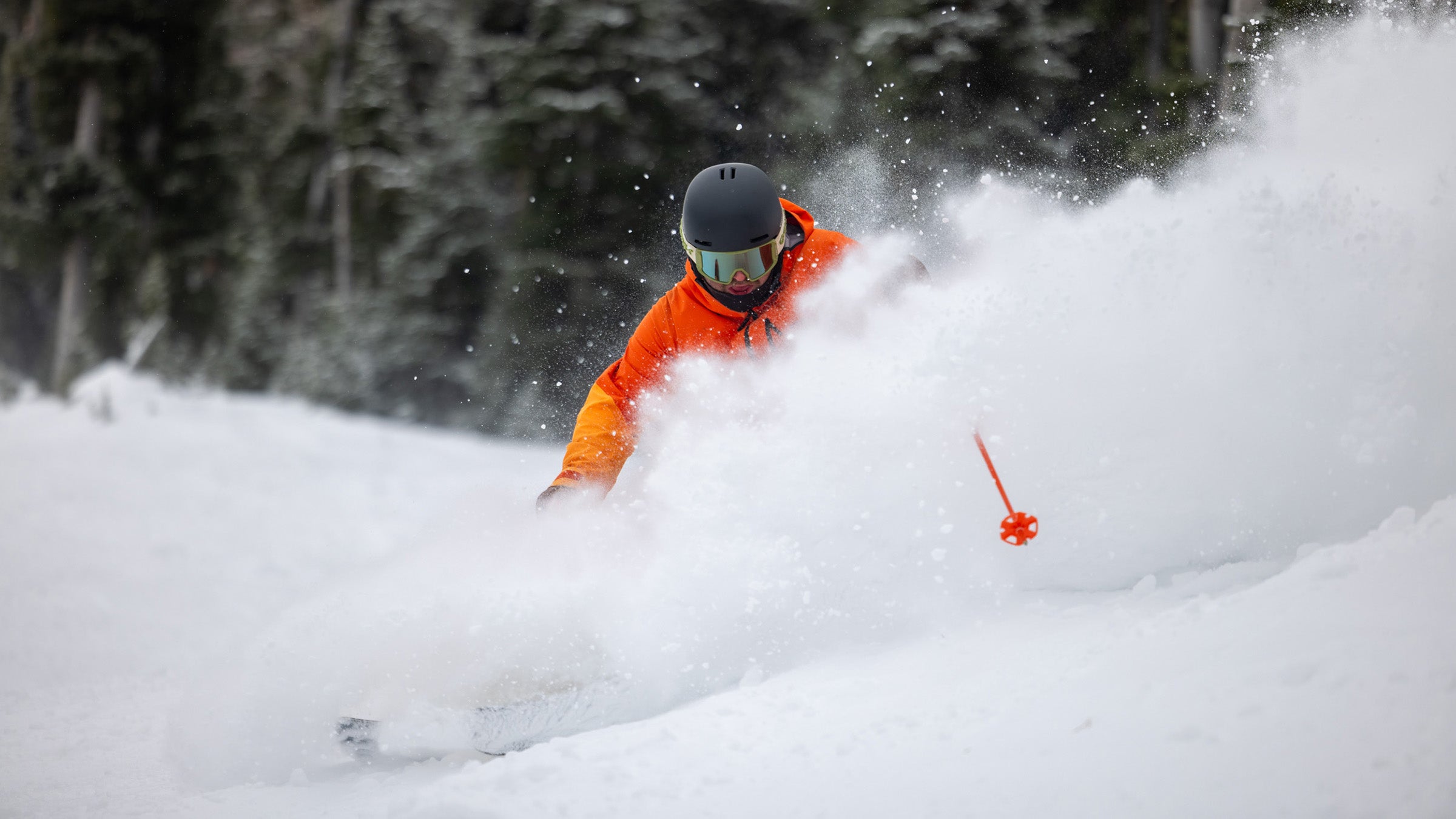
Tester RJ Peshek takes a pair of all-mountain skis off-piste and into powder to test their flotation at the 2025 SKI Test in Big Sky. (Photo: Colton Stiffler)
Table of Contents
In some ways, all-mountain skis are the most difficult to test and review—we’re necessarily looking for the jack of all trades and the master of none here. Any ski that veers too far toward firm snow stability might as well end up in the frontside category, while another that specializes in float and maneuverability could just as easily be a powder ski.
But therein lies the beauty of the all-mountain ski category: it’s got so much diversity in it. With around 90- to 100-millimeter waist widths, all-mountain skis are what you reach for when you expect to ski a little bit of everything—firm groomers, off-piste crud, and even a few inches of fresh. The best all-mountain ski is what we call a one-ski quiver: one ski that can tackle all terrain and conditions you’re likely to encounter at the resort, and get you through the season from start to finish.
Our crew of 30 testers—a mix of ski instructors, ski shop techs and buyers, race and freeride coaches, and PSIA alpine demo team members—put 17 all-mountain skis through their paces at the 2025 SKI Test at Big Sky, Montana last March, searching for the planks that can do it all. From carving up groomers and bashing bumps to chewing up crud and floating through the fluff, the eight winners listed here will leave you grinning, legs gassed and hungry for more.
Best All-Mountain Skis: At a Glance
- Best in Test: Stöckli Stormrider 95 ($1,399)
- Best for Most: Head Kore 100 Ti ($799)
- Best Value: Salomon QST 94 ($700)
- Best for Crud: Nordica Enforcer 99 ($850)
- Best for Firm Snow: Völkl M7 Mantra ($930)
- Best for Carving: Rossignol Arcade 94 ($800)
- Best for Soft Snow: Dynastar M-Free 100 ($750)
- Best Stability: Blizzard Anomaly 94 ($800)
More Skis We Recommend
- Armada Declivity 92 Ti ($750)
- Atomic Maverick 96 CTI ($750)
- Fischer Ranger 96 ($800)
- Kästle Paragon 93 ($850)
- K2 Mindbender 96C ($700)
The Reviews: The Best All-Mountain Skis of 2026
Of the 17 unisex all-mountain skis we tested at our annual SKI Test in Big Sky, Montana, these eight stood out as top performers. They earned the highest marks across nine scoring criteria, with especially strong results in versatility and crud performance—the two performance characteristics we prioritize when reviewing all-mountain skis. Read more about our testing process here.
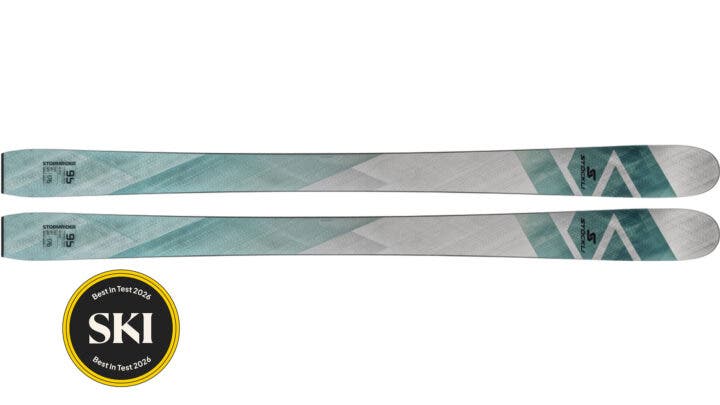
Best in Test: Stöckli Stormrider 95
Lengths: 170, 176, 182, 188 cm
Dimensions: 132-95-120 mm
Pros and Cons
⊕ Precise edging
⊕ Smooth
⊕ Comfortable at top speeds
⊗ Geared towards advanced/experts
⊗ Stiff
It’s admittedly a bit confounding that the Stöckli Stormrider 95, our top-scoring all-mountain ski, didn’t actually win top marks in any one testing criteria. Instead, it chose to spread its virtues out evenly across every metric we gauge, tickling the highest score in many departments (versatility, crud performance, hard-snow performance, and carving, among them) and showing no real weaknesses. In the end, the Stormrider 95 proved itself as the most well-rounded ski we tested in Big Sky, with only a slight preference towards hard snow and the technically-proficient skier.
With two sheets of metal, the Stormrider 95 is on the heavier and stiffer side. This makes it reliable on hard snow, in a carve, and in crud, but it also makes it a tad less playful and forgiving than other skis in this category, with a noticeable swing weight up front. The classic Stöckli brushed-metal topsheet hints at this ski’s more serious demeanor, but it’s not all business and no play; just enough tip rocker, a middle-of-the-road waist width, and softer, more elastic Polywall sidewalls that smooth out the flex, making the Storrider 95 a ski that advanced and experts will have a lot of fun on, regardless of conditions.
“I can’t rave enough about this ski,” said RJ Peshak, a 25-year-old shop tech from Aspen, and one of our most discerning testers. “It literally does anything and everything you want it to do. It’s like skiing a sports car—just super fun and reliable.”
The Stormrider 95 is, however, geared towards strong skiers who know how to pressure and drive a ski to harness its full potential. Getting shorter turns out of it requires a bit more work, with its 18.5 meter radius happier making wider arcs. That could place it a touch out of reach for the lower end of skiing abilities, but if you find yourself in the aforementioned camp, this ski will bring out the best in your skiing. Read the full review here.
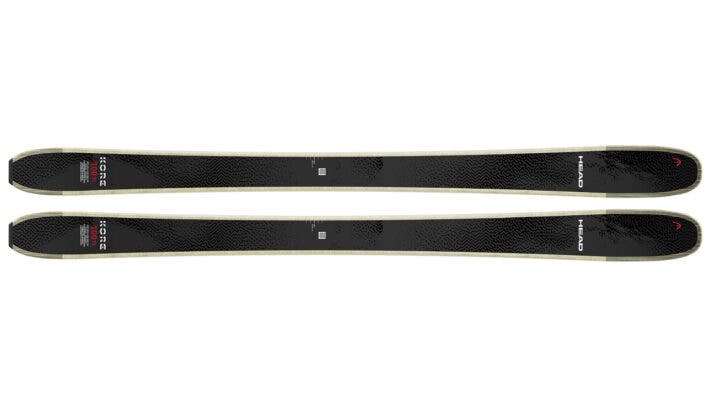
Best for Most: Head Kore 100 Ti
Lengths: 156, 163, 170, 177, 184, 191 cm
Dimensions: 133-100-122 mm
Pros and Cons
⊕ Approachable
⊕ Good flotation
⊕ Lots of available lengths
⊗ Doesn’t love short turns
⊗ Noticeable swing weight in the tip
With the all-new Kore 100 Ti, Head gave us a master class in refinement. The brand took what was already working with the Kore series (lightweight approachability) and addressed what wasn’t (unpredictable performance in crud) by infusing the new models with some much-needed Titanal. What you get with this season’s Kore 100 Ti is the same spry character we’ve come to love about the old Kore, with a bit more damping and weight to help keep the chatter down.
Despite being directional in shape, the ski’s long, low rocker in the tip and a slightly rearward mount point let you smear turns when you want, easily initiate turns, and surf in powder (it earned the highest scores in this category for flotation and versatility). As a big plus, it’s not all that demanding, making it one of the most approachable, user-friendly all-mountain skis we tested at Big Sky.
At a lean 135 pounds, tester Otto Gibbons remarked, “It’s a pleasant update that opens up the ski to more styles and positions. For those who simply want to be able to ski what’s good that day, it will open the whole mountain for you.”
Intermediates looking to up their game or expert skiers alike will be happy here, particularly if they like long turns (turn radius is 17.2 m in the 177 cm length) and a smooth ride. But experts looking for a ski that makes skiing off-piste fun, not work, are just as likely to dig this ski. The new Kore 100 Ti is a well-iterated ski with wide appeal.
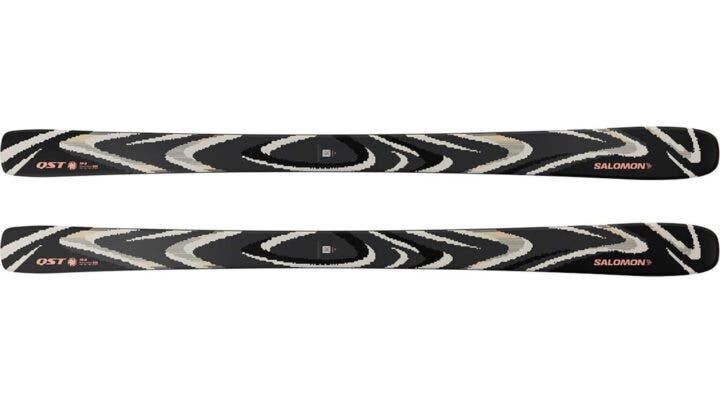
Best Value: Salomon QST 94
Lengths: 156, 164, 172, 180, 188 cm
Dimensions:134-94-120 mm (180)
Pros and Cons
⊕ Broad appeal across ability levels
⊕ Playful and snappy
⊕ Good value
⊗ A little too narrow for powder
⊗ Might have too much feedback for some
Salomon enters this season with an entirely new QST lineup of seven revamped models. The new QST 94 lands between the outgoing QST 98 and the current QST 92, with a lighter, more precise feel.
Chock that up to its construction of cork, basalt, and poplar wood, which delivers a snappy energy that can be hard to find among so many damp and stable skis these days. Despite having a fairly directional shape—with most of the rocker up front—this ski garnered our top scores for both playfulness and forgiveness. It really impressed us with how quick it turns (credit its snappy 16.5 meter radius in the 180 centimeter length), and how quick you can shut it down when you need to scrub speed.
“It’s flexible enough to be skied by a lot of skiers,” said Alex Cernichiari, a 33-year-old, 5-foot-10-inch-tall tester who calls Aspen his home mountain. “The tail held way better than any QST in years while carving, but you could still throw it around and slash and hop off moguls. I wouldn’t hesitate to have this ski in my closet.”
Some of our team called it the most versatile ski we tested in Big Sky, reporting that it transitioned from moguls to groomers to crud without missing a beat—nor asking too much, or holding anything back. That snappiness of course isn’t for everyone; it returns a lot of energy that can turn into chatter if you’re not on it. But if you find yourself lamenting skis that feel a little dead and muted these days, the Salomon QST 94 will bring you back to a familiar feeling. As expected, flotation is limited by this ski’s narrower waist, but if you move fast and think light thoughts, QST 94 will bob to the surface, happy as a porpoise.
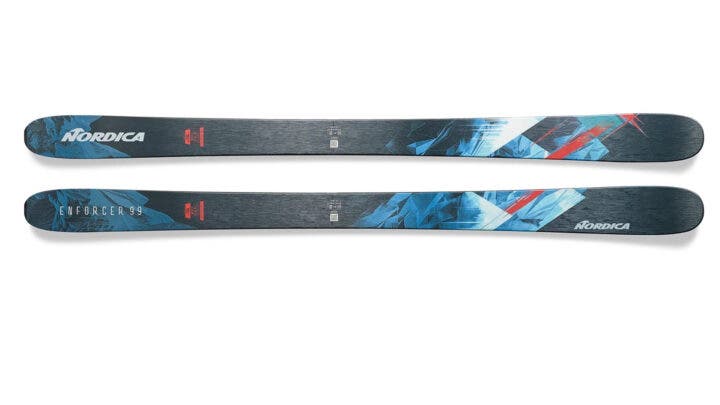
Best for Crud: Nordica Enforcer 99
Lengths: 167, 173, 179, 185, 191 cm
Dimensions: 132-99-120 mm
Pros and Cons
⊕ Burly all-mountain charger
⊕ Stable and predictable in crud
⊗ Not for beginners or intermediates
⊗ Not very playful or forgiving
As its name suggests (which evokes a gooned-up version of Wayne Gretzky), the Nordica Enforcer 99 is a smasher. While many other brands have focused on lightening up their skis and making them more approachable, the Enforcer series sticks to its guns. This is where you go for burly skis that dig in and drive.
With a stout construction that relies heavily on metal and an 18 meter turning radius (179 cm length), it’s no surprise the Enforcer 99 outperformed the other skis in the crud performance criterion at our SKI Test at Big Sky. That beefy construction, paired with generous rocker front and back, means that there’s not much that can get in the Enforcer 99’s way or slow it down. Sink into its camber pocket, and this ski finds its way over and through any obstacle.
“This is a great ski for someone who likes to charge hard,” said Dave Stergar, a 57-year-old Big Sky local and self-proclaimed ski bum. He went on to caution that only advanced skiers need apply: “The Enforcer 99 falls short of being a good ski for an intermediate or beginner skier.”
The Enforcer 99 is a freeride-focused charger made for all-mountain adventuring. It tolerates groomers, but it will only give back what you put into it. If you’ve got the jam, this could be your toast.
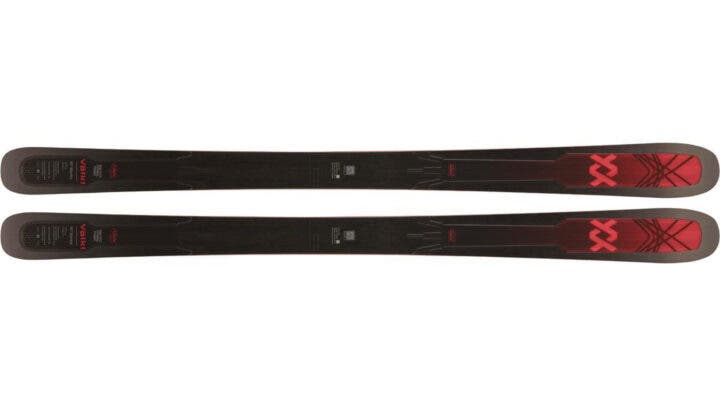
Best for Firm Snow: Völkl M7 Mantra
Lengths: 163, 170, 177, 184, 191 cm
Dimensions: 139-96-121 mm
Pros and Cons
⊕ Excels at carving
⊕ Unflappable on hard snow
⊗ Demanding
⊗ Not very lively
Imagine a steamroller and scalpel rolled into one, and you’d be getting close to the Völkl M7 Mantra. As tester Jake Stern described it, “Put this ski on edge, and it does not care what’s in front of it.”
Strong, technical skiers have long turned to the Mantra series for its sharp, directional, and powerful performance. With 96 millimetres underfoot and a wide tip, the M7 iteration is a shapely offering that likes to dig in (with all four of its turning radii), but requires an engaged pilot. Its Tailored Titanal Frame widens according to length, which means going longer equals more lateral stiffness, so picking the right length is especially important. It prioritizes carving performance on hard snow in particular, but the Titanal also allows it to soak up bumps and mix it up off-piste with the best of them.
“This is the most approachable Völkl in years,” commented tester Alex Cernichiari, a 33-year-old skier who typically skis out of Aspen, Colorado. “It’s tons of fun ripping groomers, but you can swish turns easily as well, and it doesn’t punish mistakes like it used to.”
Beginners, however, should look elsewhere. While more forgiving than previous models, the M7 Mantra still means business. Testers noted that it could be a teaching tool for strong intermediates with plenty of patience and will power. But for aggressive skiers and those who geek out on technique, this is a ski that’ll take you all over the mountain with poise and power.
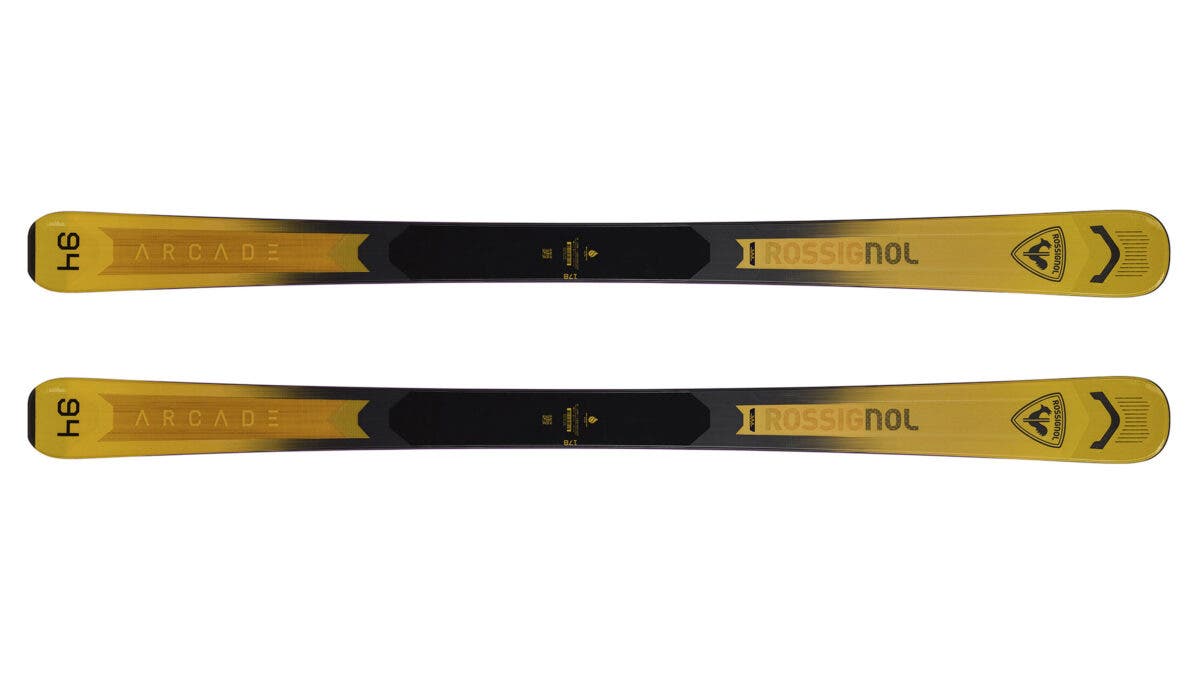
Best for Carving: Rossignol Arcade 94
Lengths: 154, 162, 170, 178, 186 cm
Dimensions: 138-94-27 mm
Pros and Cons
⊕ Carves like a GS race ski
⊕ Unfazed at any speed and in crud
⊗ A touch heavy
⊗ Sinks in softer snow
When it comes to all-mountain skis, many brands aim to make a jack of all trades that inevitably is a master at none. But with the all-new Arcade 94, Rossignol was clear on its design mission from the get-go: to make a ski that first and foremost performs well on packed snow, since that’s what most of us ski at the resort. And that’s exactly what they did.
With a stiff mid-section, square sidewalls, and a 16-meter turning radius (178 cm length), the Arcade 94 is a carving machine. In our test at Big Sky, the Arcade 94 received the highest scores in three skill departments (responsiveness, quickness, and carving)—a feat that no other ski in this category accomplished. Luke Larsen, a ski shop owner who joined our test from Snowbird, called it “a rocket ship,” adding that “arc’ing turns isn’t just for groomers anymore. It’s a fat carving ski that will dance off trail.”
But it’s not just a frontside tool. With a slightly rockered tip, it hovers just enough above crud to make riding the rails a breeze even in variable snow. At what cost? It suffers a bit when it comes to flotation and forgiveness, since a heavier ski requires a bit more speed to plane in powder; denizens of low-speed, low-effort arcs might find themselves shut out here. But that was a tradeoff our testers were more than happy with, citing the Arcade 94’s appeal for adventurous intermediates and up with strong technique and strong legs.
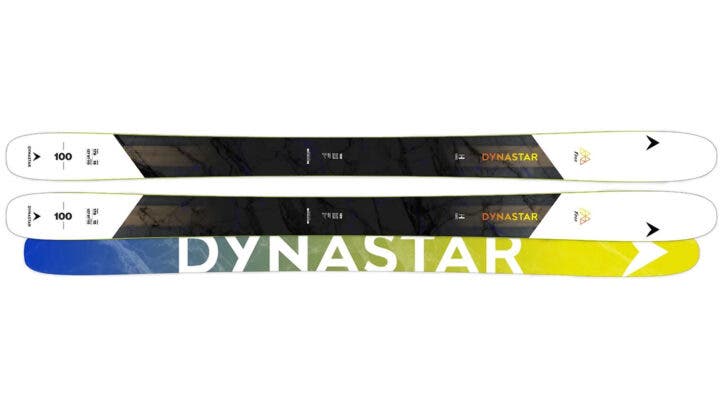
Best for Soft Snow: Dynastar M-Free 100
Lengths: 164, 170, 176, 182, 188 cm
Dimensions: 130-100-122 mm
Pros and Cons
⊕ Both playful and powerful
⊕ Smooth ride, absorbs everything
⊗ Lacks pop
⊗ Not the best on firm snow
If there’s one country that loves freeride, it’s France. So it should come as no surprise that Chamonix-based Dynastar continues to fixate on big mountain prowess with its new M-Free 100. With the same turning radius (17 meters at 179 cm) and only 8 millimeters narrower than the Dynastar M-Free 108, it feels as though this new charger is only toned down from the wider version in waist size. As Mammoth-based tester Jake Stern put it, “This is a narrow freeride machine!”
If charging full-throttle down big lines is your thing, the M-Free 100 is close to as good as it gets: With a strong camber profile and ample rocker front and back, it’s damp, dependable, and smooth at speed and in crud. The only small knock amongst our more piste-oriented testers was a slight lag in turn initiation on groomers and a clear preference for softer snow. But the tradeoff was unending stability in all terrain, and a playful character that allows for smearing and breaking free of traditional turn shapes.
“This is for skiers who want a damp and stable but loose freeride feel to explore all over the mountain,” Stern summed up. The new M-Free 100 might be a bit much for the lower end of the intermediate spectrum, but if there’s one thing worth fighting for, it’s freeride.
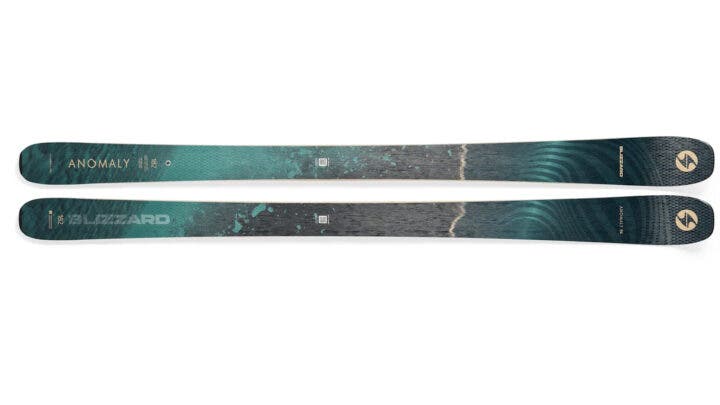
Best Stability: Blizzard Anomaly 94
Lengths: 162,170,178, 185, 192 cm
Dimensions: 132.5-94-114.5 mm
Pros and Cons
⊕ No speed limit
⊕ All the power you could want
⊗ Requires a strong skier
⊗ Heavy and lumbery
Returning with only graphic updates for a second season, the Blizzard Anomaly 94 continues to excel on hard snow and groomers thanks to a burly wood and metal core that makes this ski exceptionally damp, smooth, and reliable at speed. At a stout 2,100 grams per ski (176 centimeter length), it’s no wonder that the ex-racers in our test crew felt right at home on it. Our strongest skiers felt that while damp, the Anomaly 94’s long, low tip rocker allows it to skip over uneven snow and crud, making it a fun ride on and off the groomed.
However, our shorter, lighter testers cautioned that the swing weight is noticeable with this beast, and sizing down is perhaps a good call. “Stronger skiers will love the dampness of the Anomaly 94,” noted veteran tester Jon Sexauer, who clocks in at a modest 160 pounds and 5 feet 7 inches. “It’s super quiet and smooth on groomers and in chopped-up snow, but a bit of a handful in tighter bumps and trees. You definitely need to stay on top of them or else they’ll buck you.”
With an 18.5 meter radius (182 cm length), this one likes to roam: think big turns, strong technique, and lots of speed, and you’ll get along with the Anomaly 94 just fine. Bonus: Since the flex profile of the wood core is tuned to each specific length, the ski’s feeling of stability persists even in the shorter sizes—so don’t be shy about choosing a shorter length.
More Skis We Recommend
The following all-mountain skis are models that excel in specific areas like playfulness or forgiveness, offering strong alternatives for skiers with specific performance preferences.
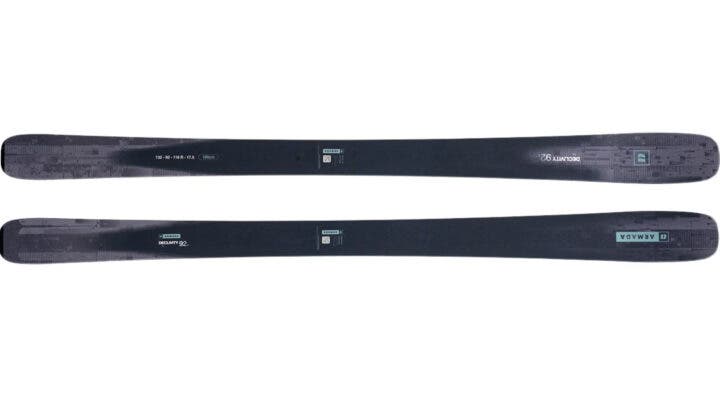
Armada Declivity 92 Ti
Lengths: 164, 172, 180, 188 cm
Dimensions: 132-92-118 mm (182 cm)
Pros and Cons
⊕ Nimble
⊕ Has the stability of a heavier ski
⊕ User-friendly
⊗ Tails don’t release easily
⊗ Deflects in crud
With the Declivity 92 Ti, Armada strikes an admirable balance between hard snow and soft snow performance. While it wasn’t one of the top performers all-around at our test in Big Sky, it did impress in the playfulness department. Credit its lighter construction, energetic wood-meets-metal core, and 17.5 meter turning radius (180 cm length) for its agile, lively feel. One of Armada’s best tricks is delivering a lot of skiability in shorter lengths in their skis, and that continues here. The 92 Ti benefits from all the stiffness and dependability of a longer ski, in a less bulky, more agile package.
The Declivity 92 Ti’s lighter construction comes with the typical penalty of easy tip deflection; testers also noted that the tail felt extra grippy in hard snow, making it harder to release turns at the drop of a hat. Still, the Declivity 92 Ti is a spritely ski with a freeride feel that pushes through crud, rails on piste, and isn’t hard to maneuver in tight spots like trees and chutes. If you like power in a lightweight package, this might be the sweet spot.
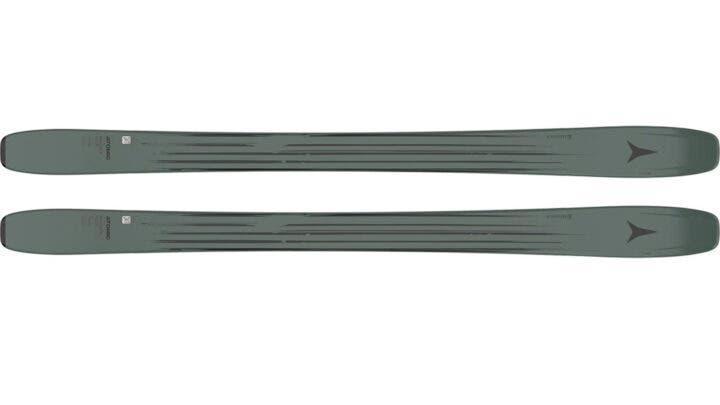
Atomic Maverick 96 CTI
Lengths: 165, 172, 179, 186 cm
Dimensions: 129-96-114.5 mm
Pros and Cons
⊕ Maneuverable
⊕ Low barrier to entry
⊕ Playful and floaty
⊗ Can get tossed around in crud
⊗ Lacks some guts on hard snow
Anybody with an affinity for a ski that pivots—whether you’re on the light end of intermediate or an expert that just likes those kinds of turns—will dig this ski. Featuring a new waist width for the expanding Maverick franchise, the Maverick 96 CTI is light and maneuverable with a freeride spirit and progressive mount point. But the big story is how dependable it is without being demanding. Because, really, does skiing need to be a fight? Save that for 10 percent Tuesday at Costco.
Compared to the winners on this list, it’s not as dependable on hard snow, groomers, and in crud. The feathery nature of the ski can let it get pushed around a bit, but the metal inside helps to dampen those deflections when they do come up. Its 3D tip—which is bevelled at the edges like a boat’s prow—also helps prevent the tips from hooking up, and promotes flotation. It’s not our top pick for skiers out East, but for Westerners who gravitate towards a quick, maneuverable ski and get to ski softer snow more often than not, this is a worthy option.
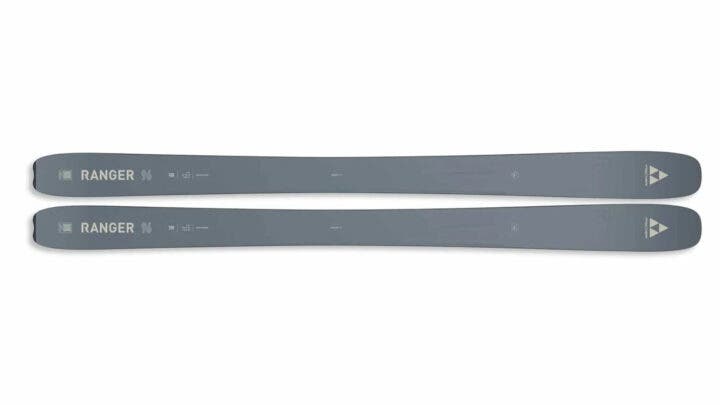
Fischer Ranger 96
Lengths: 159, 166, 173, 180, 187 cm
Dimensions: 129-97-120 mm
Pros and Cons
⊕ Great intermediate option
⊕ Floats, even at low speed
⊗ Lacks bite on hardpack
⊗ Chatters at high speed
A light, energetic ski with a directional character, the Fischer Ranger 96 has been a longtime favorite for its user-friendliness and superior flotation for its waist width. With just 96 millimeters underfoot, it’s a far cry from a powder ski, but its long nose and forgiving flex makes turn initiation a breeze and lets the ski plane to the surface at lower speeds, making it a great option for less aggressive skiers looking to up their game in powder, or anywhere else.
Those looking for a truly grippy ski on hardpack and groomers might be let down—there’s just not enough heft or backbone here to offer the kind of rock-solid stability of some of the other skis on this list; but if you prioritize pivoting and saving your legs, you’ll find this ski plods along well enough on groomers and crud to be worth it.
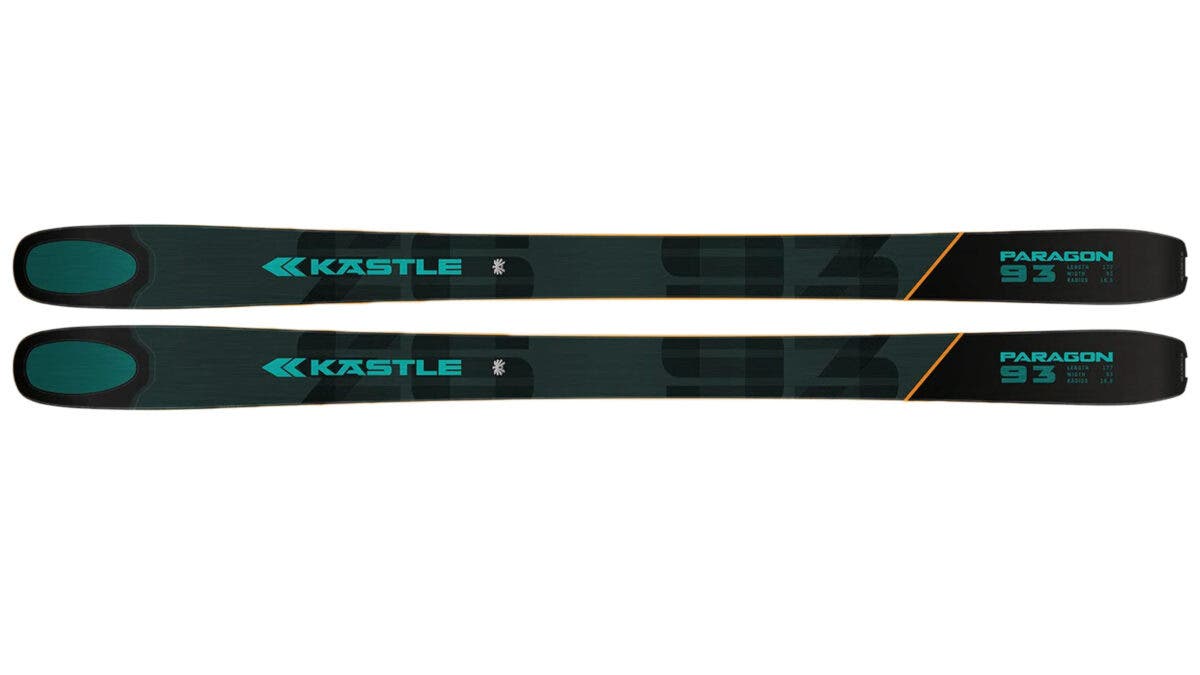
Kästle Paragon 93
Lengths: 163, 170, 177, 184 cm
Dimensions: 128-93-115
Pros and Cons
⊕ Unstoppable if you’re on top of it
⊕ Super smooth
⊗ Tip chatter
⊗ Doesn’t love soft snow
With two sheets of metal, Kästle’s Paragon 93 exists at the business end of the all-mountain spectrum. It’s an advanced- and expert-oriented slicer designed to cut through hard snow, crud, and groomers. Sure, it can go off-piste, but it loves hard snow. Testers called it a confidence-inspiring ski that handles most of the mountain with ease—for stronger skiers.
A modicum of tip rocker does allow for some versatility, but it’s not overly eager to rise up in powder, only humors bumps, and kind of tolerates trees. The tip will chatter if you let your foot of the gas; this ski is made to grip and drive. It’s not a ski we’d recommend to up-and-comers or those looking for a lighthearted all-mountain ski that makes adventuring off-piste effortless. But you can’t argue with this ski’s performance on hardpack. The Paragon 93 is a good option for an ex-racer, powerful technical skier, or anybody who mostly wants to ride the rails and feel locked in.
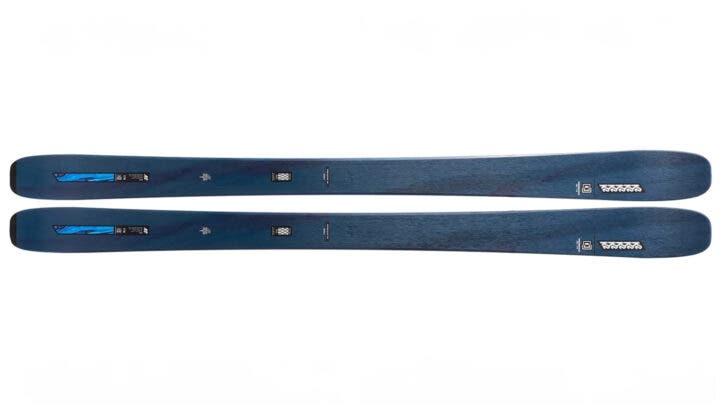
K2 Mindbender 96C
Lengths: 166, 172, 178, 184 cm
Dimensions: 131-96-119 mm
Pros and Cons
⊕ Beginner-friendly
⊕ Adaptable to many skiing styles
⊗ Might be too flimsy for aggressive skiers
⊗ Not as reliable on hardpack
There’s this idea that skiing should be hard, and that good skis should push back. But K2 long ago called bullshit on that notion, and with the Mindbender 96C, puts forward a super accessible sliding and slarving machine that prioritizes good times. Like to get a little loose? Don’t want to feel like you’re steering a semi truck around all day? This is your ski.
The only caveat: really aggressive skiers might find themselves undergunned here. The ski does feel a bit averaged out in its characteristics—kind of like a Honda Civic, it’s good at everything but not amazing at any one thing. But, overall, the Mindbender 96C remains a great, easy all-mountain option for beginners and intermediates that’s still got enough freeride personality to satisfy lighthearted experts, too.
Best All-Mountain Ski Comparison
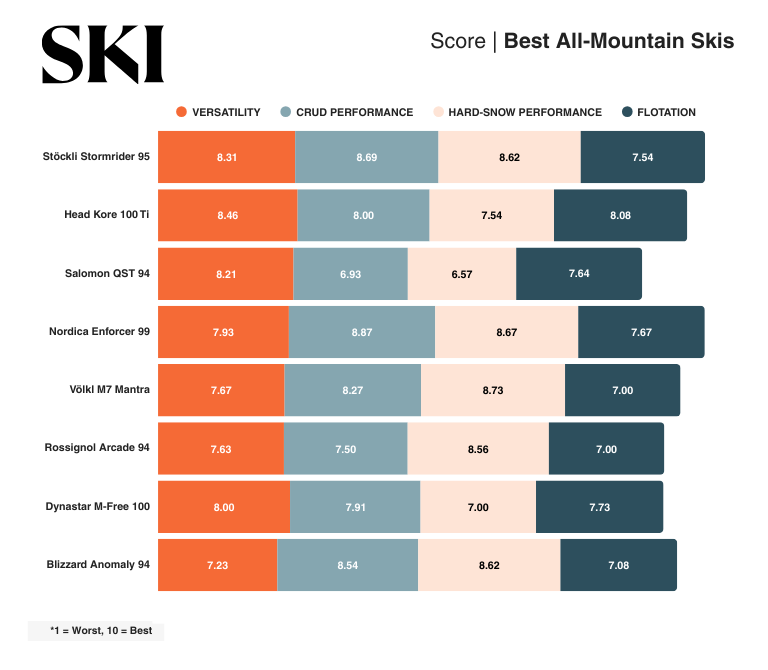
How Does SKI Test and Review Skis?
About SKI Test
- Skis tested: 17
- Testers: 30 expert skiers from the ski industry
- Location: Big Sky, Montana
- Tester range: Ages 21–57 | Heights 5’4”–6’3” | Weights 125–250 lbs
Each year, SKI’s editorial team conducts one of the most rigorous and trusted all-mountain ski tests in the industry. At the 2025 SKI Test in Big Sky, Montana, 30 experienced skiers from across the country tested 17 unisex all-mountain skis in real-world resort conditions. To reduce subjectivity, all testers skied each model on the same day, in the same conditions, and submitted digital scorecards evaluating each ski across nine criteria:
- Versatility
- Crud Performance
- Stability at Speed
- Responsiveness
- Carving
- Quickness
- Forgiveness
- Playfulness
- Flotation
When judging the best all-mountain skis, we place the greatest emphasis on versatility and crud performance—two key indicators of a top-tier all-mountain ski. The eight winners on this list earned consistently high marks across all categories, especially those two. The skis included in the “More Skis We Recommend” section are models that excel in specific areas like playfulness or forgiveness, offering strong alternatives for skiers with specific performance preferences. Learn more about our testing methodology and scoring criteria here.
Why You Can Trust Us
Our ski reviews are the result of the largest, most rigorous on-snow test in the industry. We never charge brands to participate and don’t guarantee coverage—our annual SKI Test is a fully independent editorial project designed to deliver objective, in-depth reviews. Our 12 expert testers include ski instructors, ski patrollers, ski shop owners, hardgoods buyers, ski technicians, and race and freeride coaches. We handpick this crew for their professional expertise and intentionally include a range of body types, ages, and home mountains to reflect the broader ski community. Bottom line: There’s no pay-to-play here—just honest feedback from people who know skis. Meet some of our veteran testers below.
Jake Stern
Age: 30 | Height: 5’11” | Weight: 170 lbs
Prior to joining Outside as a digital editor in 2023, Stern held many jobs within the ski industry, but the one constant has been his focus on gear. He was a professional bootfitter at Footloose Sports in Mammoth Lakes, Calif; a ski bum waiting tables at Alta and skiing 120 days a year; and served as editor at Powder and Freeskier. A lifelong skier and gear nerd, he spends every free minute of his winters skiing Mammoth Mountain and exploring the Eastern Sierra backcountry.
Chad Jacob
Age: 43 | Height: 5′10″ | Weight: 195 lbs
Jacob is a ski race coach from the East Coast—and he skis like one. At his home hill of Bristol Mountain, N.Y., you’ll likely find him carving up icy groomers on a set of skinny skis. Jacob is a veteran gear tester who has tested skis for both Outside and SKI.
RJ Peshek
Age: 25 | Height: 5’10” | Weight: 250 lbs
Peshek was born and bred in Aspen, Colorado, and works as a shop tech for Hamilton Sports. If he’s not in the shop, he’s out on his local hill, Aspen mountain (aka Ajax). He’s been testing gear for SKI for three years.
Frequently Asked Questions
What is an all-mountain ski?
From groomed runs to moguls to the steep-and-deep freeride terrain, all-mountain skis are designed to take on the entire mountain—groomers, bumps, trees, back bowls—and all snow conditions. They usually feature a waist width from 85 to 100 mm and are sold without bindings.
The majority of all-mountain skis that our testers prefer feature wood cores and one or two sheets of metal in their construction—but there are exceptions. Some skis leave out the metal altogether in favor of keeping the ski light and more playful.
It’s hard to beat the versatility of an all-mountain ski, though these skis can be too wide for those who spend the majority of their time on groomers, and too narrow for those who ski mountains blessed with regular and bountiful snowfall.
What is the best all-mountain ski for men?
Our top all-mountain ski for men in 2026 is the Stöckli Stormrider 95. It outperformed all the other unisex all-mountain skis we tested in Big Sky, Montana. Testers raved about its smooth handling on- and off-piste, its versatility, and its dependability no matter the conditions. Read the full review here.
What is the best all-mountain ski for women?
For 2026, our testers named the Rossignol Arcade 94 W the best all-mountain ski for women. It’s an incredibly versatile all-mountain ski that handles everything from groomers to bumps and crud confidently. Energetic and easy to turn, it’s a great choice for intermediates to experts. Read more about the Rossignol Arcade 94 W here.
What’s the difference between all-mountain and frontside skis?
Truth is, the line can be blurry between these two ski categories since ski manufacturers now work hard to produce well-rounded and versatile skis in both. As a result, you can now find narrow all-mountain skis (closer to 90 mm underfoot) that also rail on groomers and frontside skis (typically between 80-90 mm underfoot) that can hold their own in crud.
That said, there are still some key differences between frontside and all-mountain skis, the biggest being that frontside skis are primarily designed for on-piste performance, while all-mountain skis (even the narrower ones) are engineered to tackle conditions and terrain off the groomers. Learn more here.
What’s the difference between men’s and women’s skis?
In truth, most skis are unisex and not gender-specific. Many brands produce the ski with the exact same construction technologies for both genders, but often create two different top sheets/graphics to appeal to men vs. women. In general, men and women can use the same ski but may want to choose different lengths depending on their height, weight, and their skiing style/ability. A handful of brands design true women’s skis with construction tweaks for female physiology. These skis generally come in shorter lengths (from 170 cm down to 150 cm) and use slightly softer, lighter construction materials.
How long should skis be?
As a general rule of thumb, the shorter the ski, the easier it is to turn and control. So if you’re a beginner, reach for a ski that’s about chin-height. More advanced skiers often choose skis that are as long as they are tall, since longer skis provide more stability at speed and float in deep snow. So the best ski length for you will depend on your height, your skill level, and what type of skiing you hope to do. A ski-shop employee can help point you in the right direction.
Note that ski length is relative. Narrow carving skis tend to ski longer than their length because they feature more effective edge, while powder skis tend to ski shorter than their length because they feature more rocker in the tip and tail. Learn more here.
How long do skis last?
With proper care and regular maintenance performed by a professional ski tech, skis can last for 200 to 300 days on snow, depending on the size and aggressiveness of the skier. Larger skiers and people who are harder on their equipment will not get as many days on snow before the wood core, edges, or other aspects of the ski become compromised.






